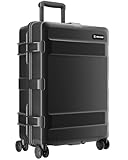The Science of Crushproof: Engineering Analysis of the Pelican ATX Waterproof Luggage
In the sterile, climate-controlled world of airport terminals, most luggage is designed to look good for the first five minutes. Polycarbonate shells gleam, zippers glide, and wheels spin effortlessly. But shift the scene to the cargo hold at 30,000 feet, or the back of a Land Rover in a monsoon, and the design priorities of fashion luggage quickly collapse.
The Pelican ATX is not designed for the runway; it is engineered for the tarmac. Born from a lineage of military and industrial equipment cases, it applies the principles of extreme containment to personal travel. To understand why a traveler would choose a case that weighs nearly 20 pounds empty, we must look past the weight penalty and into the physics of polymer resilience and hydrostatic sealing.

The Polymer Paradox: Rigid vs. Resilient
The primary failure mode of hard-shell luggage is cracking. When a standard ABS or Polycarbonate case is dropped on a cold tarmac, the material often behaves like glass—it is hard, but brittle.
The Pelican ATX utilizes Polypropylene (PP). This material choice is deliberate.
* Molecular Flexibility: Polypropylene is a semi-crystalline thermoplastic. Its molecular chains allow for a degree of flex under impact. Instead of shattering, the shell absorbs the kinetic energy of a drop, deforming momentarily and then returning to shape. This is the difference between a “shield” that breaks and “armor” that absorbs.
* Chemical Inertness: Unlike other plastics that can degrade with exposure to jet fuel or solvents found in industrial transit, PP is highly resistant to chemical attack, ensuring the structural integrity remains intact over decades of abuse.
The Hydrostatic Barrier: IP67 Engineering
Water is the silent destroyer of travel gear. A standard zipper is essentially a sieve. The ATX eliminates zippers entirely in favor of a Tongue-and-Groove interface fitted with a continuous O-ring Seal.
The Mechanism
When the heavy-duty latches are clamped down, they compress the polymer O-ring between the lid and the base. This creates a hermetic seal rated at IP67.
* 6 (Dust): Totally protected against dust ingress. Important for desert environments.
* 7 (Water): Capable of withstanding immersion in water up to 1 meter depth for 30 minutes.
This isn’t just about keeping clothes dry in the rain; it’s about protecting expensive electronics or sensitive gear from total submersion during a boat transfer or a flood.

Atmospheric Physics: The Purge Valve
A perfectly sealed box creates a new problem: Vacuum Lock.
As an aircraft climbs, cabin pressure drops. The air inside a sealed case expands. Upon descent, external pressure rises, but the high pressure inside remains trapped if the seal is perfect. Conversely, rapid cooling can create a vacuum, sucking the lid down so tight it becomes impossible to open.
The Pelican ATX integrates an Automatic Pressure Equalization Valve.
* Gore-Tex™ Logic: The valve typically uses a hydrophobic membrane (like Gore-Tex) that allows air molecules to pass through freely, equalizing the pressure differential, while blocking water molecules. It allows the case to “breathe” without drinking. This passive system ensures the case opens easily at sea level or at base camp, without compromising its waterproof rating.
Mobility Dynamics: Hinomoto Engineering
A heavy case must move effortlessly. The ATX employs Hinomoto Wheels, the gold standard in caster engineering.
* Bearing Precision: Unlike generic wheels that rely on simple axle friction, Hinomoto wheels use sealed ball bearings. This reduces rolling resistance significantly, allowing a fully loaded 50lb case to glide across smooth concrete with the touch of a finger.
* Axle Geometry: The dual-wheel design distributes the load, reducing the PSI on each contact patch and preventing flat-spotting when the case sits loaded for long periods.

Conclusion: The Heavyweight Champion
The Pelican ATX is an exercise in trade-offs. You trade the lightweight convenience of a zipper bag for the absolute certainty of a crushproof vault. You trade interior volume (lost to the thick walls and wheel wells) for the assurance of IP67 protection.
For the casual vacationer, it is overkill. But for the professional carrying camera gear, the adventurer traversing variable climates, or the traveler who simply refuses to accept broken zippers and cracked shells, the ATX is a piece of industrial infrastructure disguised as luggage. It is built not just to carry your belongings, but to defend them.

